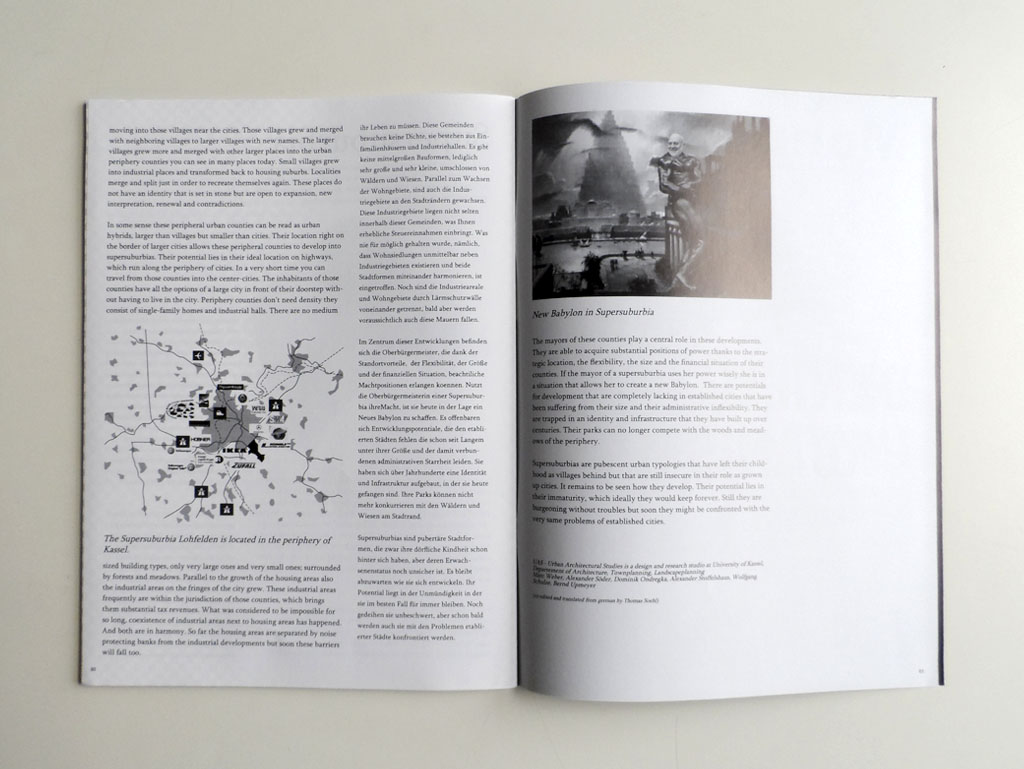18-04-05 // UNIVERSITY OF KASSEL

“Supersuburbia” on page 59 of MONU’s issue #3
In the summer term of 2005 Bernd Upmeyer teaches a theoretical seminar entitled “Supersuburbia” at the University Kassel in Germany. Parts of the results of this seminar are published in MONU Magazine’s issue #3 on “Political Urbanism”.

Pages 60 and 61
“We got a new city form. Without anyone noticing a new type of city has developed. While everyone was talking about the future of the sprawling urban fringes those places have been developing into urban typologies that are superior to cities: supersuburbias.
Supersuburbias are small towns with around 20,000 inhabitants located on the fringes of larger cities. They are mergers of multiple villages but still disguised as village-counties. In reality however we are dealing with a specific form of city that is employing a camouflage strategy – cities in village’s clothing. Since the 70’s the middle class has continually been moving into those villages near the cities. Those villages grew and merged with neighboring villages to larger villages with new names. The larger villages grew more and merged with other larger places into the urban periphery counties you can see in many places today. Small villages grew into industrial places and transformed back to housing suburbs. Localities merge and split just in order to recreate themselves again. These places do not have an identity that is set in stone but are open to expansion, new interpretation, renewal and contradictions.
In some sense these peripheral urban counties can be read as urban hybrids, larger than villages but smaller than cities. Their location right on the border of larger cities allows these peripheral counties to develop into supersuburbias. Their potential lies in their ideal location on highways, which run along the periphery of cities. In a very short time you can travel from those counties into the center-cities. The inhabitants of those counties have all the options of a large city in front of their doorstep without having to live in the city. Periphery counties don’t need density they consist of single-family homes and industrial halls. There are no medium sized building types, only very large ones and very small ones; surrounded by forests and meadows. Parallel to the growth of the housing areas also the industrial areas on the fringes of the city grew. These industrial areas frequently are within the jurisdiction of those counties, which brings them substantial tax revenues. What was considered to be impossible for so long, coexistence of industrial areas next to housing areas has happened. And both are in harmony. So far the housing areas are separated by noise protecting banks from the industrial developments but soon these barriers will fall too.
The mayors of these counties play a central role in these developments. They are able to acquire substantial positions of power thanks to the strategic location, the flexibility, the size and the financial situation of their counties. If the mayor of a supersuburbia uses her power wisely she is in a situation that allows her to create a new Babylon. There are potentials for development that are completely lacking in established cities that have been suffering from their size and their administrative inflexibility. They are trapped in an identity and infrastructure that they have built up over centuries. Their parks can no longer compete with the woods and meadows of the periphery.
Supersuburbias are pubescent urban typologies that have left their childhood as villages behind but that are still insecure in their role as grown up cities. It remains to be seen how they develop. Their potential lies in their immaturity, which ideally they would keep forever. Still they are burgeoning without troubles but soon they might be confronted with the very same problems of established cities.”
Institution: University of Kassel
Course: Supersuburbia
Department: Architecture, Urban Planning and Landscape Planning
Type: Theoretical seminar
Position: Assistant professor
Date: April 2005
Location: Kassel, Germany
Publication: MONU #3 – Political Urbanism, pages: 59–61